‘If there’s one thing we know about ancient Egypt, they did death better than anyone else.’ So spoke the British archaeologist Tony Robinson on a dig at the Aswan tombs in 2018. What he didn’t say is that the more archaeologists dig up, the more they face the same baffling questions. Why, in different parts of Egypt, have so many tombs been found empty? Why mummification? What are the enigmatic Pyramid Texts and the Book of the Dead all about? And the biggest question of all: what did the ancient Egyptians know about death that, thousands of years later, we don’t? Immortality—life after death—seems to have preoccupied them above all else, and we don’t know why.
The Kolbrin contains six ancient Egyptian books, the remnants of scrolls written or copied by scribes from much earlier writings. These enigmatic books, whose provenance has not yet come to light, may one day be recognised as a record of humanity’s distant past—but something even more mysterious can be found there: dotted throughout are writings about ancient Egypt’s search for immortality.
Why mummification?
Surprisingly, what the Kolbrin says about immortality has little to do with mummification– indeed, it is rather dismissive of the practice. Mummification, it says, dates back to a far distant time when a group of refugee priests from an advanced civilisation arrived in Egypt after a global cataclysm and found the human beings around them reduced to barbarism.
‘Children wandered the plainland like the wild beasts, for men and women became stricken with a sickness that passed over the children.’1
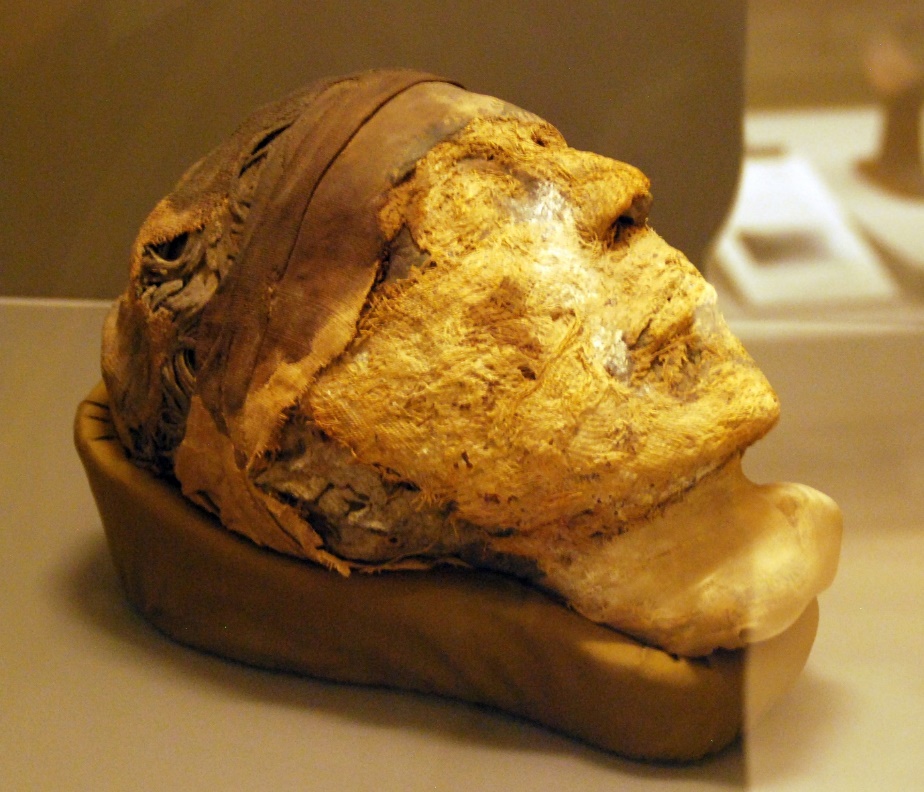
Mummified head of Djehutynakht, believed to have been Governor of Hermopolis, 11th-12th dynasty. Marcus Cyron [CC BY 3.0].
‘The priests who came from the Land of Copper could make their soul depart from the body at their command and return as they willed. When ignorant men saw seemingly dead bodies return to life when the soul came back into them, they thought the same could happen to a dead body if kept long enough… Later… men believed that if they kept a dead body so that it remained whole, the soul would not finally enter the Sphere of Accounting. Such was the knowledge of their wickedness and fear of their fate that they used every art to prevent the body falling apart and entering decay.’2
‘The priests sought to preserve their wisdom and knowledge and pass it on to their children, but it became distorted and misunderstood. They [the children] did not understand the radiating power from the bodies of the dead, which could guide the living. Even we do not understand these things clearly.’3
In other words, mummification was a superstitious practice which developed when less advanced human beings misinterpreted the metaphysical abilities of more advanced people. Osiris, says the Kolbrin, was pragmatic about mummification; he recognised that people needed comfort when their loved ones died. ‘Who taught the preservation of the body? That the soul might commune with the living, and that it might be a doorway to the Earth?’ says a later hymn to Osiris.4
‘Osireh it was who himself ordained that as their [the pharaohs] bodies were filled with vitalised spirit essence, they should be preserved, to keep such power bound to Earth for its good.’ 5
These texts are difficult to understand because they contain knowledge of the soul and spirit that humanity has abandoned or lost. However, they suggest that mummification resulted from a profound misunderstanding of the astounding spiritual powers of Osiris and his companions; that as the centuries wore on, preservation of the body became ossified into mainstream religious practice. However, the amazing skill of making a soul depart from its body and return at will continued to be used during the secret Hibsathy ritual.
What was the Hibsathy?
At the heart of the Egyptian books lies a mysterious ritual recorded (to my knowledge) nowhere else. In The Book of the Sons of Fire it is called ‘the Hibsathy’ or ‘the Ritual of the Twice-Born‘.6 The Twice Born were
‘those who have endured the awfulness of the false death which many do not survive; who have drunk deeply from Koriladwen, the smooth bitter brew which releases the spirit; who have entered Ogofnaum through the thundering doors.’7
The scribe describing the ritual (he was writing in another country, several generations later) issues a warning:
‘These things must not be entrusted to common folk, neither must they be degraded by disclosing them to such as would profane them. They were once reserved for those who were exalted in wisdom and virtue.’8
He goes on to say that, among the Sacred Mysteries, the Hibsathy ritual was ‘one of the Lesser Mysteries‘. (Reading what was involved, one can’t help wondering what the Greater Mysteries might have been!) It was
‘a ceremony to regain spiritual vigour and to restore spiritual power, whereby a Chosen One dies and rises again. It is a grim undertaking fraught with danger. It is not for the spiritually weak or for the faint-hearted. Not all survive to walk again upon the friendly ground of Earth…’
Why die and rise again?
This was a ritual, not to remove death itself, but to remove the inexorable fear of death which has accompanied human beings from time immemorial.‘The Aspiring Ones of Earth may cross the dread horizon through residence within the Cavern of Stone,’ says the Book of Scrolls.
‘It is thus that men come to know the Truth concerning the Realms of Glory beyond the Western Horizon, but it is a path beset by great dangers and manifold terrors, and many return witless… Only the older men who had completed the three cycles of seven years were accepted. They had to be men with wisdom and courage… strength and fortitude… absolute purity and complete self-discipline.. self-sacrifice and a strict sense of duty… Only men possessing all these qualities could cross the border in consciousness and return. To be deficient in any essential quality meant death.’9
Hibsathy and Heb Sed
What does ‘Hibsathy’ mean? Perhaps the closest Ancient Egyptian term is ‘Heb Sed’. Robert Bauval writes that during the Heb Sed festival or royal jubilee,
‘The pharaohs of Egypt [undertook] a sort of potency test in order to determine whether their reigns were to be renewed or terminated. The Heb Sed normally took place after the thirtieth year of [their] reign, but there is evidence that suggests that [a] shorter period (seven years is often quoted) also applied.’ According to G.A. Wainwright in his book The Sky Religion in Egypt,
“nothing is more certain than that the pharaoh was divine…Kings of this type contained within themselves the power that produced prosperity…The service rendered by such kings has always been to ensure the fruitfulness of the earth, and consequent health of the people…”
Wainwright concluded that the Heb Sed festival belonged “to the old sky and fertility-religion”, and that the ceremony itself “went back at least into prehistoric times.” One of the important rituals performed by the king during the Heb Sed was a curious race which required the king to run around the boundary walls of the ceremonial complex.’10
Two boundary stones in the Heb Sed court of King Djoser’s pyramid mark where the king performed his ritual run, and a false doorway inside his pyramid shows him running. The presence of a false door might provide a clue to how the Heb Sed originated. False doors, found in mortuary temples and tombs across ancient Egypt, were believed to serve as passages between the worlds of the living and the dead.
[Click here to see the carving of King Djoser running the Heb Sed on a false door in Djoser Pyramid.]
Could the Heb Sed have originated as a ritual far more profound than the later, more superficial ritual of the king’s run? The Book of Manuscripts says:
‘Such was Pharaoh, a god below gods, a man above men. He was bound by the decrees of olden times… one whose task was to reveal God to men… They were a family, a race apart, taught to regard the people as their own children…11 Originally this worked perfectly, but… somewhere, down through the ages, the dam of spirituality sprang a leak and that which had hitherto been hoarded and guarded ebbed away. The divinity… in the blood was diluted… When kings and governors rose to position and power, they declined the ordeal. It is understandable, for the final ordeal brought earthly life as close as possible to extinction…’12
Did the prospect of the ‘final ordeal’—crossing the border in human consciousness—prove so daunting that an easier ceremony was devised for pharaohs to perform?
Three forms of worship
The Kolbrin tells us that in Egypt, not one, not two, but three forms of worship were practised:
‘Throughout all times there have been two visible forms of worship… that of the highborn and that of the people…The worship of The High God and the knowledge of the Sacred Mysteries, kept hidden by the Enlightened Ones and the Twice Born, were behind both and veiled within them…’
In other words, the oldest form of worship, which included the Sacred Mysteries—among which was the Hibathy—was kept entirely secret.
‘Strife most grievous’
According to the Kolbrin, the public and hidden forms of worship came into conflict at least twice. The first conflict occurred before the Great Flood when ‘the land was rent in twain and the forces of the Red Reed Crown strove against those of the White Lily Crown…’. Below is a much-abridged version of the second conflict:
‘…Twenty generations before the evil Amuleka [Hyksos?] descended like locusts upon the land, there was strife most grievous…
‘The thoughts of Setshra ever turned about within himself and… he… conceived a plan whereby the multitude would be admitted to participate in the Sacred Mysteries hitherto kept exclusive for the worthy ones among men. He gathered together a following… and promised… that the knowledge of sacred things hitherto kept from them should now become available… The new teachings grew in strength and spread throughout the whole land… Though the followers of Setshra could not discover the higher secrets, they learned the lower ones and these were twisted… Thus was developed the worship of dark spirits… that perverted the thoughts of the people… they rose up, clamouring for the blood of the righteous ones.
‘Now, Setshra gained the ear of the king and… overwhelmed the heart of his Majesty… Then new shrines were set up in the temples, new forms of worship appeared… The hidden places of the Enlightened Ones were profaned with wickedness and the secret chambers of the Twice Born were polluted with vile rites… In the temples dedicated to many different gods, the forms of worship were subtly changed… The servants of the Dark Ones left not even the dead to rest in peace, but sought to satisfy the living with words from beyond the tomb. Even the blood of men was offered in dark places… and … children… tormented to give pleasure. The hosts of the Dark Ones were well skilled in battle and they drove out all those who stood against them… The sacred shrines… were spoiled. The ornaments of beauty and the sacred vessels were taken away… The Enlightened Ones and the Twice Born were hunted down… slain and buried… like dogs.
‘The Leader of Light… fled into the land beyond Shari and built there the Temple in the Rock, which stands against Shina.13 In this land the forces of the Dark Ones were cast back… Then, in the generation of Pahopha the name of Osireh began to be known [once more] in the land and for twelve generations it grew in greatness… Ten generations entered into their Eternal Habitations and Tathomasis (Thuthmose I?] came… He, too, could no more stay the hand of decay than could the meanest slave. Then, in his day Nabihaton [Akhnaten] came to rule in the land of Egypt.’14
In other words, the Old Religion with its Sacred Mysteries, which had been virtually destroyed early on, gradually revived; it went through a hiccup during Nabihaton/Akhnaten’s reign but was restored after his death, only to be virtually obliterated later and its adherents forced to flee Egypt forever.15
Matching the Kolbrin with historical records
Do any historical facts back up what the Kolbrin says? Historians have this to say:
‘The 2nd Dynasty is a period of extreme obscurity. The order of the first few kings is reasonably clear, but later in the dynasty hierarchy becomes much more uncertain and there are definite signs of disorder, if not full-scale civil war. Immediately prior to this we find a king who, rather than employing a Horus-name, called himself “the Set Peribsen”.’16
and
‘It has been suggested by some Egyptologists (e.g. Newberry, Cerny, Emery and Grdseloff) that Sekhmet/Peribsen might have been a usurper or that under his rule a religious or political revolution took place.’17
The Kolbrin’s ‘Setshra’ may well have been the religious usurper Sekhmet/Set Peribsen, and Setshra’s story commemorated in the Set/Horus combat myths.
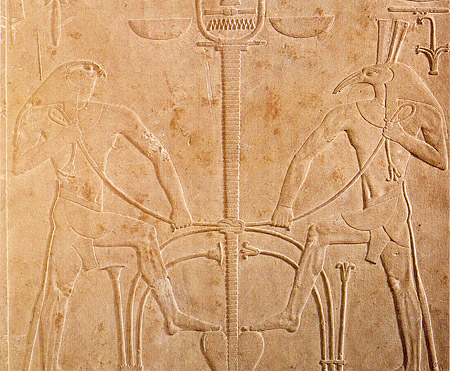
Horus and Set in combat. Relief from a throne of Senwosret I/Senusret/Sesostris, 12th Dynasty, Cairo Museum. Soutekh67 [CC BY-SA 4.0]
The Hibsathy Ritual
Below is a slightly abridged version of the Ritual of the Twice Born:
‘The Anointed One went into the first Chamber of Darkness for testing by one of the Twice Born of a lesser order. Here it was discovered whether he truly desired The Great Illumination and whether he had all earthly desires and ambitions under control. Here he was warned of the dangers he would have to face… Before him now there was only one choice, victory or death.
‘Now the candidate and he who attended upon him stood before the next door, and the priest said… “Having realised by his own preparation, that the external is unreal and having eliminated earthly desires and substituted spiritual ones, he who aspires stands ready. He has tamed the wild steed of his bod… He has awakened the man within the man, and the eyes of inner vision are open. He… is one ready to go forward”.
‘The Anointed One was admitted into the second Chamber of Darkness and here he was uncovered and placed within a bath of cold water where he remained for a period determined by the burning of a lamp… From here the Anointed One passed into a small chamber which was the entrance to the Caverns of Initiation. He now stood before the Portal of Restuah [Rostau] and recited… “O Unnameable God, give me a burden of suffering to bear and place about my shoulders the yoke of tribulation. O God, fill the empty spaces of my spirit with pain. O grant me such fortitude that even under an almost unendurable load of distress I may be willing to lighten the burden and suffering of another. Even as I stand prepared for the awaiting test, I ask that should I be returned to the light of Earth, I be granted a share in the afflictions of others, for I need the strength given by suffering and sorrow, and will welcome them…”
‘Then one who stood in this place gave the Anointed One water to drink and said… “O Unnamable God, hear the prayer of the Anointed One. Strengthen him with such courage and fortitude that he will not fail in his hour of awful trial, but shall pass beyond the Place of Terror through the Portal of Death, and… return unharmed in spirit and body.”
‘The Anointed One entered the first Cavern of Initiation and was tested there in such manner that no ordinary mortal could endure it. After three days he came out saying to one who stood there, “O acceptable suffering, what has been decreed is indeed best.”
‘After passing through the first two Caverns of Initiation the candidate became an Enwrapped One, and in the last small Cavern of the Lord of the Twice Born released his spirit. The Enwrapped One was then placed within the Womb of Rebirth and there, within the tomb of stone, he was left seven days. Here came complete liberation of the spirit. It floated out through the confining stone and went as it willed. No words of men, however learned, can ever describe this experience. The spirit of the Enwrapped One returned to the body at the behest of the Lord of the Twice Born, and he who had survived became a Twice Born One…’18
The scribe writing this account adds, somewhat sadly,
‘It was not an ordeal required to obtain something man has never possessed, it was to regain something he had lost. It was, however hard it may seem, the lowest price payable for the Secret of the Ages.’ 19
He says that he has ‘drawn the curtain aside a little to reveal only what is permitted’—in other words, details have been left out. Drugs are not mentioned in this account, but elsewhere the Kolbrin speaks of the Twice Born as those ‘who have drunk deeply from Koriladwen,20 the smooth bitter brew which releases the spirit.21
The Hibsathy’s spiritual benefits
How did a Twice Born feel after surviving this almost unimaginable ordeal?
‘When led forth into the Place of Glorification his face shines with an inner beauty indescribable. From that day onward his conduct and attitudes are changed and he is at peace with all men and with himself. He needs nothing from earthly life and seeks nothing. He accepts and enjoys whatever life offers, for he has learned the answer to the riddle of life and solved the Secret of the Ages… Having arisen from the Womb of Rebirth, the spirit is completely freed from any doubt about the immortality of man. Can a man doubt the source of sunlight when he can see the sun arising in glory before his eyes?
‘The spirit of the Twice Born can be liberated at will… It is a state beginning in quiet bliss, flowing outward in bright radiance from an inner light which can even illuminate the material darkness about him. He hears the music of the sacred spheres and sees the throbbing pulsations of life heaving about him… Material objects lose their density and become visible within, they become as though compounded of ten thousand whirling spheres of brightness. Colours are no longer dull and restricted, they become infinite in depth and number… The soul is aware of something glorious within all this and knows it for the spirit outflowing from its source… It is the sea that washes the shores of eternity lapping upon the nearer strand… It is the earned reward of those who have paid the price.
A few shamans or mystics of our time might possess this lasting ability; the nearest most people get to this blissful state are the finite sensations offered by meditation and psychedelic drugs.
‘It is not the only reward, for throughout the life of one who is Twice Born there is boundless feeling of wellbeing, sickness and disease are unknown. There is an abiding love for all men, a sense of brotherhood, and over all this the certain knowledge of the immortality of the soul and its unity with its source… There are flashes of inspired visions, and the future unrolls and can be read as the past… a form of joyous rapture… and when it comes it can no more be held back than the sun can be stayed in its rising…
The man who was has navigated the winding waters of life and crossed the dark waters of death… is now strengthened in wisdom. He takes a seat on high, that he may become an instructor and guide on the path. He becomes… a homing light to guide those who seek Truth. He is purified and comes forth wearing the White Mantle of Greatness.’
The ‘White Mantle of Greatness’ sounds like the garment associated with Osiris.
Hibsathy in the Celtic Books
Surprisingly, a first-person account of the Hibsathy exists in the Kolbrin’s Celtic Books, written by a prophet called Elidor:
‘I was a Sleeper in the Great Stone Chambers of Initiation, the voices of the Instructing Spirits spoke to me and I answered with the words of power. I prepared myself by the Dread Rites and became worthy to be called an Inheritor of the Ancient Wisdom… When a man enters the Great Stone Chambers of Initiation he receives an infusion of the Divine Essence. His soulspirit is awakened to conscious awareness and passes out, to leave the mortal body still and silent within its tomb. He comes into the presence of Beings who know the will of The Supreme Spirit, he learns awful secrets, he knows whence he came and whither he goes. He is one reborn and awakens to rediscover himself.
In the Place of Terror I saw other things, I learned the secret of the serpent with its tail in its mouth. I saw the workings of the spawn of evil and the fungus of corruption. I gazed upon the Dark Ones and when they saw me they became vicious, they sought to attach themselves to me… But I was strengthened against them and came forth uncontaminated.’22
Buried alive for a week?
When I first read these accounts, I was deeply skeptical. Was it possible, physically and spiritually, for the Egyptians to break on through to the other side? Then one day I stumbled on the autobiography of the Egyptian Copt Hamid Bey (c. 1890s-1976). In My Experiences Preceding 5000 Burials, Bey describes his training at a Coptic temple—learning thought transference, how to withstand physical pain and how to experience cataleptic trance—abilities which later allowed him to be buried alive on many occasions. He writes:
‘You think it is wonderful that I can be buried for three hours, five feet underground without air reaching me, and yet emerge as alive as ever?… One of the members of the Coptic Brotherhood to which I belong put himself into catalepsy… and… willed that he should awake in six days… When they opened up the airtight casket after six days, the wise man… was unconscious half a day… But at the end of the day he came back as well as ever.’
In 1837, in Lahore, India (now Pakistan) the hatha yogi and fakir Sadhu Haridas was recorded as surviving burial for 40 days at the court of the Maharaja of the Punjab, Ranjit Singh.23 This feat and his subsequent resuscitation is recorded by James Braid in Observations on Trance in Human Hybernation (John Churchill, 1850).24 The book includes other instances of burial and resuscitation, including one where a man’s teeth were ‘joined so fast together, that the by-standers were obliged to force open his mouth with an iron instrument, in order to pour a little water down his throat’. This forced opening of the mouth sounds identical to the ancient Egyptian ‘Opening of the Mouth’ ritual after death; perhaps the process, like the Heb Sed, was dimly remembered from earlier times and persisted as ossified ritual.
Hamid Bey writes of his Coptic training: ‘This Master Temple has been in continual activity all these 9,000 years, its Masters teaching and developing those abilities… which lie dormant in the minds of ordinary people…’25 Much of Egypt’s Old Religion seems to have been preserved down the centuries by the Copts. In The Land of Osiris, Stephen S. Mehler writes:
‘During the 1990s, Bob Bawter and I delved deeper into the literature with the works of Schwaller, Hall, Edgar Cayce, West and Blavatsky. We became convinced… that there had indeed been an inner group of adepts, masters and initiates who had directed the course of ancient Egypt and had inherited their wisdom and knowledge from an even more ancient civilization. These people were known in various sources as the Inner Temple, the Hermetic Brotherhood of Luxor, the Master of the Hidden Places, the Brotherhood of Tat, the Brotherhood of the Snake, or just simply the Brotherhood.’26
Were these Masters the people whose records the Kolbrin preserves?
Hamid Bey does not mention that he experienced a journey to the other side. However, a recent, well-publicised example of near-death experience (NDE) closely echoes parts of the Kolbrin description. For over twenty-five years, Dr Eben Alexander worked as an academic neurosurgeon at Harvard Medical School in Boston, Massachusetts, USA, dealing with patients rendered comatose by trauma, brain tumours, ruptured aneurysms, infections or stroke. At that time, he maintained that the brain generates consciousness, mind and spirit. In November 2008 he was driven into coma by a rare bacterial meningo-encephalitis. He spent a week on a ventilator, his prospects for survival diminishing rapidly. On the seventh day he woke up. Memories of his life had been completely deleted while in coma, yet he retained vivid memories of a fantastic journey into another realm. His son advised him to write down everything he could remember before reading any records of near-death experiences. Six weeks later, he completed his initial record. Then he started reading—and was astonished by the similarities between his own journey and those reported by other cultures and millennia. His subsequent bestseller, Proof of Heaven: A Neurosurgeon’s Journey into the Afterlife, maintains that human beings are conscious in spite of their brain and that consciousness survives bodily death.
Compare the following description in the Kolbrin with Alexander’s own memoir:
‘A hundred shining suns whirl above, a whisper rolls around like thunder, lights of manifold hues sway above, like the river reeds in the wind. All things appear to dance in a shimmering haze, then turn over and fold back into themselves, and such beauty is produced that the human tongue cannot describe it. All things take upon themselves shimmering forms through which other forms can be seen. Great melodic music throbs all around, while everything pulsates a soft rhythm. The air is filled with voices of unearthly sweetness, glory and splendour are everywhere.27
‘Higher than the clouds—immeasurably higher—flocks of transparent orbs, shimmering beings arced across the sky, leaving long, streamer-like lines behind them… A sound, huge and booming like a glorious chant, came down from above… The sound was palpable… Seeing and hearing were not separate in this place where I now was. I could hear the visual beauty of the silvery bodies of those scintillating beings above, and I could see the surging, joyful perfection of what they sang… Everything was distinct, yet everything was also a part of everything else, like… a butterfly’s wing.’28
Other consciousness-crossing rituals
Two rituals similar to the Hibsathy are recorded in the Book of Scrolls. One produced an Enlightened One, the other an Initiated One, and they sound different from the Twice Born Ritual.
Ritual of the Enlightened One
This ritual mentions several drugs taken beforehand. Below is a much-abridged version:
‘The Aspiring One… sits within the cavern before the Cauldron of Rebirth and Regeneration, and inhales the smoke from the brew of release. He rises above himself, flying on wings of five feathers… His body moves without the spirit and partakes of the sour yellow bread of wide vision… drinks the brew of grey barley29 and sips long at the wine of harish, [Arish?]30 eating the cakes of green brown horris [orris?31]. He eats the fruit of the releasing tree and drinks the brew of black fungus, which is in the smoke goblet.32 Thus, he sleeps and the attendants lay him down in the receptacle called the Womb of Rebirth… He shall be covered and made so that in his struggles he rise not. His voice is heard speaking in a strange tongue, as he calls on his fathers who have gone before… His body becomes still, as he enters the dazzling chamber which is the doorway to twin vision.
‘Now he must penetrate the Walls of Dry Air which bar his passage, and rise into the rainbow-coloured Clouds of Radiance…. High up he looks below him and sees the waters of the Winding Canal of Experience and understands the meaning of all that had befallen him. Now he has four eyes, these being the inner and outer eyes, and rising higher he attains the heights of wide consciousness. Here he meets the Pathfinder and follows him… speaks rightly to the Guardian… shields his eyes when passing the Lurker on the Threshold… until he comes to the abode of the Opener of the Ways.
‘Now the body of the Aspiring One becomes restless and those who attend him place the power of Hori [Horus] over his face. He hears the voice of the Sungod… becomes covered with moisture, he writhes, he shouts, he struggles… he… has been seized by the Fiends of Darkness, but he… prevails over them, and all is well…
‘A hundred shining suns whirl above, a whisper rolls around like thunder, lights of manifold hues sway above… All things appear to dance in a shimmering haze, then turn over and fold back into themselves, and such beauty is produced that the human tongue cannot describe it. All things take upon themselves shimmering forms through which other forms can be seen. Great melodic music throbs all around, while everything pulsates a soft rhythm. The air is filled with voices of unearthly sweetness, glory and splendour are everywhere.
‘Then the Aspiring One awakes. He is raised… he comes forth… He staggers, he cannot walk unsupported. His throat burns… His head resounds… He is given the sweet waters in the cup of forgetfulness and drinks deeply, all is well. He is a Reborn One, he is an Enlightened One. He is one resurrected from the Cavern of Stone.’33
Ritual of the Initiated One
This ritual includes a vision of the weighing of souls. Below is a much-abridged version:
‘The door of Heaven stands ajar, the doors of vision have been opened and now the Cavern of Vision is revealed… ‘The Welcomers stand back… The Brilliant One is there and another who is the Reciter’.
The Reciter accompanies the candidate on his journey and explains the visions:
‘”O Brave stouthearted one, Syoltash to be, the things you behold are the things seen by the Great Ones of Earth when they came this way in their hour and were returned back to life…”
‘The Reciter then explains the meaning of what the candidate sees before him: The twin star…The pool… The rays dancing about… The clouds obscuring the lesser lights… The dark twins standing by the pillar…The stream of clear water… The brightness… and… a much greater brightness reflected from afar… The repulsive shapes… behind the flame…The gloominess and shadow scene…The flickering lights… The darker spots… The redness… The blue whiteness… The brightness above and ahead… Behold, here is a Rising One newly arrived, see, she flies upward on the wide wings of spirit and loving arms reach out to welcome her. The star-girt roadway you see rising before you is that trodden by the countless Risen Ones who have gone before. Now, advance towards the left…
‘The abyss… before you is the mouth of Earth, and see, it opens and speaks to you, bidding you farewell. Listen carefully, for it will retell your… accomplishments and your omissions. If they weigh against you, then cast yourself into the abyss, for you are unworthy to survive this trial… If you have not been found wanting in the weighing, then step forward… without fear, for the mouth will close to let you pass. If you are not numbered among the triumphant ones, then better by far that you be swallowed forthwith than that you survive to meet the Dread Lurker, the Devouring Horror, and be returned to Earth a witless, empty shell.
‘Beyond the abyss lie… the Pool of Wisdom and the Pool of Purification. Therein you must… refresh yourself. The trees growing to your right bear the fruits of spiritual nourishment, eat and become strong… You will see a cliff against which is a ladder… the Ladder of Experience… The rungs are your daily deeds and thoughts and fantasies… Now is the test. Will your daily deeds and secret thoughts support your ascent…? See, above is your Kohar [a part of the soul], call upon it for help, for therein you may have stored a reserve of spiritual strength. Or… it may be barren and empty, only you know…
‘The ladder leads onto a plateau, and beside you appears the… Reciter… He leads you to the place where sleeps a serpent, and… says, “Behold the serpent it sleeps at the bole of a tree from which hangs the body of man, the tree of his backbone. It is on guard, safeguarding the precious gem of spiritual powers… To rouse this serpent… causes a fire to mount into the heart, which may destroy the brain with delusions and madness. Only the Twice Born can really obtain the gem.
‘You pass on with the Reciter who will say: “…You must establish in your heart, the knowledge of the eight roads along which you must travel to reach the Land of the Westerners. These will bring you to the twelve first portals leading to the Land of Shadows. Here I will recite for you the twenty-two deeds of wickedness you have not done. You will then pass through the Land of Shadows as if it were your hour, and, beyond it, come to the Great Portal where it must be established, before the Great Guardian, that you have ever done all within your power to live according to the twelve virtues. Then you pass through the portal to the Hall of Judgement. Here… is made known whether your tongue has spoken in accordance with the things within your heart… If the words of the tongue are… a true copy, then cross to the Place of Assessment where your true form and likeness will be displayed for all to see.”
‘A curtain of darkness descends, there is a heavy dark mist, then the muffled crash of Thundering Doors. The aching body reclines within the tomb of stone. The questing pilgrim has returned to his homehaven. He has learned truths he could never learn on Earth and now knows the Grand Secret. Faith is replaced with certainty and he is now an Initiated One.’34
What was ‘the House of Hidden Places’?
Linked to these rituals was ‘the Master of the Hidden Temple’ and ‘the House of Hidden Places’ where the rituals went on. The Kolbrin says:
‘Men read the Great Book of the Master of the Hidden Temple. They die and take it with them, but there is no power in their words, and who but we, the Enlightened Ones, know the hidden meanings?’35
Since parts of the Book of the Dead are frequently found in Egyptian tombs, it sounds as if ‘The Great Book of the Master of the Hidden Temple’ was the original name for what we now call ‘the Book of the Dead’. If so, then the Kolbrin is saying that the book was deliberately constructed to contain a secret meaning which would be incomprehensible to anyone who was not an Enlightened One. Those who wrote the Book of the Dead did their work well, for many thousands of years later we are as baffled by what it means as most ancient Egyptians would have been.36
The first House of the Hidden Places
The Kolbrin states that ‘the first Temple of the Shrine of the Hidden Places was built on the Sacred Heights’.37 Were these ‘Sacred Heights’ Hermopolis or were they the Giza plateau? According to the Kolbrin, the First Temple of the Shrine of the Hidden Places was
‘a temple within an inner court where there were lesser temples and the rooms of priests and teachers. The whole was surrounded by a courtyard and gardens, and beneath the main temple were the three Caverns of Initiation.’
The second House of the Hidden Places
‘Later,’ says the Kolbrin in the same passage, ‘the Temple of the Shrine of the Hidden Places was built during a time when the light was revealed throughout the land. Though previously the shrines of the Twice Born had been concealed in the smaller temples, when Ramsis [Ramses—but which Ramses?] built the Great Temple of Ramen [Amun?] it contained, within itself, both temple and shrine of the All Highest God. Also there were Caverns of Initiation underneath.’
A detailed description of the Temple of the Shrine of the Hidden Places follows, but many of the identification points given are ceiling and wall symbols which would have been destroyed or worn away long ago, making it impossible to follow the clues.38 However, it seems likely that the Great Temple of Ramen was the temple of Amun at Karnak; if so, then there is one set of underground rooms in the complex which fits the Kolbrin description: a now-neglected building beside the sacred lake known as the Edifice of Taharqa.
The function of this curious building has never been understood. The Edifice’s original excavation notes make clear that although it was built by the Pharaoh Taharqa in the 26th Dynasty and contains stones used by his predecessor Shabaka, Taharqa was reusing a much older building.39 The final room in the building is nothing less than an underground pit, which might have been used for Hibsathy burials. Could the Edifice be the remains of the Caverns of Initiation?
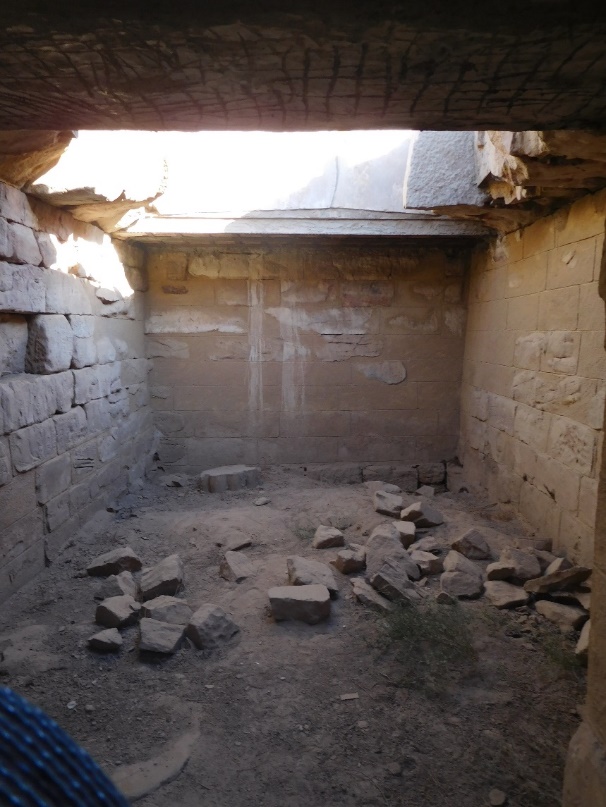
The final underground room of the Edifice. The stones lining the back floor mark the edge of the pit. Photo: YW
Intriguingly, the Edifice of Taharqa stands precisely at the centre of Karnak; if diametric lines are drawn from the four corners of the complex, they intersect over the building. Is this mere coincidence, or could the Edifice once have been the beating heart of Karnak?

Map of Karnak adapted by the author to show the Edifice of Taharqa (red lines) directly at the centre. Taken from ‘The Akhenaten Temple Project and Karnak Excavations’ by Donald B. Redford, Vol. 21, Issue 2 (1979): https://www.penn.museum/sites/expedition/the-akhenaten-temple-project-and-karnak-excavations/
Another House of the Hidden Places
The Book of Manuscripts describes yet another House of the Hidden Places. No geographical location is mentioned, but it sounds distinct from the first Temple of the Shrine of the Hidden Places (which had a temple within an inner court/lesser temple, rooms of priests and teachers, a courtyard, a garden and three Caverns of Initiation):
‘Now the Great House of the Hidden Places stands in Kahemu [Kmt = the Black Land/Egypt]. It is built to last forever and stands up strongly towards Heaven, high above the heads of men. It is covered with white stones, the white stone of Rehakom was cut for it, and above it is topped with copper. It is not the copper of men, but the copper of God. Within it lies the Womb of Rebirth used by the Twice Born of the Enlightened Ones. Men enter its portals to die and come out restored to life, reborn as gods. Beside it stands the Temple of the Radiant Ones, many-pillared and walled about. Here is the Great Portal of Entry into Life, and above it, on a great stone, these words may be seen: “From the Children of God to the Children of Men. Behold, we found you in bondage to mortal bodies and bestowed upon you the gift of everlasting life.” ‘
It is tempting to interpret this as a description of the Great Pyramid, but the text suggests otherwise. First, it uses the word ‘portals’—and the Great Pyramid does not have portals; secondly, it goes on to say, ‘Beside it stands the Temple of the Radiant Ones, many-pillared and walled about. ‘ 40 ‘Many-pillared and walled about’ is a precise description of what we now call the ‘Valley Temple’, and the Valley Temple happens to stand beside the best contender for the Temple of the Shrine of the Hidden Places—the ruinous ‘Sphinx Temple’.
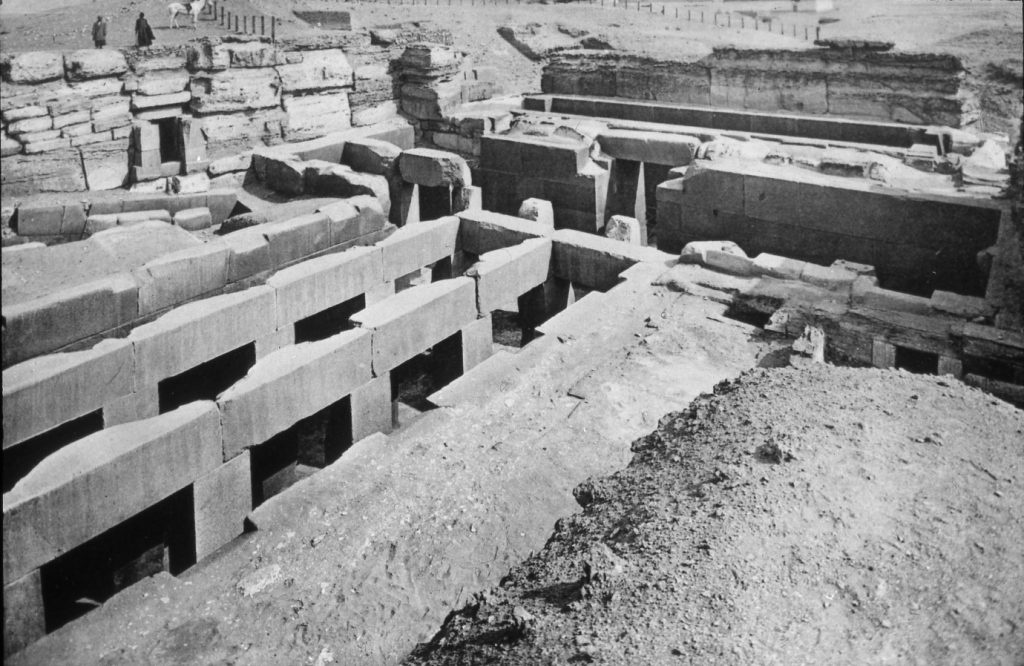
Valley Temple showing its columns and surrounding wall. Lantern Slide Collection, William Henry Goodyear – Brooklyn Museum, Public Domain
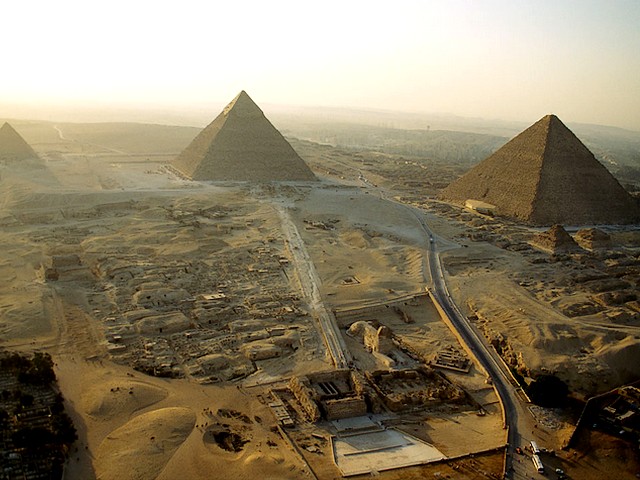
Aerial view of Giza showing, in the foreground, the Valley Temple standing beside the ruinous Sphinx Temple, By http://puzzles-games.eu
Robert Temple has explored and written about the Sphinx and Valley Temples more thoroughly than anyone else. He notes:
‘Looking at it [the Valley Temple]… facing towards the pyramids, one sees the massive eastern façade with its two doorways, one at the south and one at the north [the portals]… Once you go through one of the doors, which are very high… a niche made of granite very far above head height looks down on you; no one knows whether it contained a statue, or what its purpose was.’41
[Click here and scroll to ‘SUPPLEMENTARY PLATE 7-39′ to see the eastern façade of the Valley Temple, with the top of the Pyramid of Menkaure behind. On the right is the empty niche in the upper portion of the granite north entrance hall.]
Could this niche once have held the great stone inscribed ‘From the Children of God to the Children of Men’? If so, it would certainly have been torn down between the 2nd and 4th dynasties when Setshra destroyed the Old Religion’s sacred shrines, along with the temple beside it. As Temple says, ‘All Egyptologists are agreed that the Sphinx Temple was probably wholly buried from Old Kingdom times until 1936, a period of more than 4,000 years.’42
Temple has also spotted something in the Sphinx Temple overlooked by Egyptologists—a deliberately-constructed groove which has been dismissed as a waste-water conduit (see colour plate 23 showing the groove in Egyptian Dawn: Exposing the Real Truth behind Ancient Egypt, Arrow Books 2011). He writes:
‘I believe that the groove was constructed as a cable-guide for lowering something incredibly heavy such as a basalt sarcophagus into a subterranean tomb… A close inspection of the granite basal slab-ends to either side of the groove as it opens into the Sphinx Temple shows pretty clear signs of a pattern of lateral wear… this may be evidence of a cable bearing some heavy load swinging from one side to the other as it emerged from the groove, wearing away the granite.’
He cites an observation made by the Egyptologist and architectural historian Herbert Rüdiger Ricke (1901-76):
‘Ricke describes it [the grooved structure] as having two channels, which suggests a double-cable arrangement, perhaps for continual raising and lowering. Alternatively, there could have been a counter-weight on the end of one cable… I have found two more granite cable grooves in the Valley Temple itself… which could have been used for raising and lowering any number of heavy objects into the subterranean depths immediately to the west of the temple.’
Could this system have been used for the final stage of the Hibsathy ritual, when ‘the Enwrapped One was then placed within the Womb of Rebirth and there, within the tomb of stone’? Only further excavation beneath the two temples can answer these questions.
Temple also notes the dazzling white remnants of stone used to build the Sphinx temple:
‘Being familiar as I already was with the fragments of alabaster from the Hawara Quarry… I recognised that the Sphinx Temple material was purer, whiter, bulkier and more beautiful… The translucent quality of the “alabaster” and also its extraordinary sparkling beauty and pure whiteness would have seemed wonderful to the ancient Egyptians, as indeed they do to me.’
[Click here and scroll to ‘SUPPLEMENTARY PLATE 7-9′ to see the court of the Sphinx Temple, showing several dazzling white stones in the foreground.]
Temple’s observation could well apply to the Kolbrin’s description, ‘It is covered with white stones, the white stone of Rehakom was cut for it…’
If the Sphinx Temple was indeed the Great House of the Hidden Places, then a candidate emerging alive from the Hibsathy Ritual would have gone through the Great Portal of Entry into Life into the Temple of the Radiant Ones and taken his place reborn as a god.
The spread of the Hibsathy
At the end of the Hibsathy text the scribe writes:
‘…the age of the Twice Born draws to its close. Because of those who have devoted their lives to the discovery of Truth, there is progress in the sphere of the spirit. Nothing has been lost, nothing has been in vain; the Great Gates are still closed, but they are no longer bolted. Now they will open at a knock. The road is better marked and the way more clearly indicated.’
With no chronology provided in the Egyptian books, we do not know when this was written, so the mystery deepens. The Book of the Sons of Fire says that
‘The wisdom of the Twice Born has spread to every corner of the Earth, and Caverns of Initiation are opened everywhere. But increasingly, through the years, men have declined to undergo the austerities and trials essential to bring them into the clear light of Truth. Therefore, the places of initiation decay and their secrets are lost, men grope in the dark and try to open a door to which they have no key.‘43
Where did the Hibsathy spread to? Did the Celtic prophet Elidor undergo his ordeal in Britain? A ritual of this nature was certainly practised in Eleusis, in Greece. Could it have been the Hibsathy? In The Ritual Path of Initiation into the Eleusinian Mysteries, Mara Lynn Keller writes,
‘As initiates moved through a death-like experience to rebirth, they received a special vision. In the fifth century BCE, the Greek lyric poet Pindar wrote of this experience of the Eleusinian Mysteries and those initiated who pass on to the Elysian Fields: “…Happy is he… having seen these rites… for he knows the end of life and he knows its god-sent beginning.”‘44
Another thought: is it possible that the Hibsathy has been retained, if only symbolically, by the Freemasons in their rituals of fire and water?
Empty sarcophagi, empty tombs
All over Egypt, great sarcophagi have been found lying empty. Could any of them have been used at some time for the Hibsathy? The underground Osiris Shaft at Giza is a likely candidate: when found, it contained several empty sarcophagi and it also has fresh water which might have been used during the ritual.45 The Osireion at Abydos and the Edifice of Taharqa are both underground structures with fresh water at hand. The so-called King’s Chamber of the Great Pyramid contains an empty sarcophagus which at one time might have been used for a similar purpose, as does the Pyramid of Khafre/Chephren—though nowhere in the Kolbrin’s metaphysical pages are pyramid structures mentioned, so perhaps pyramids were built to perform another, non-metaphysical function.
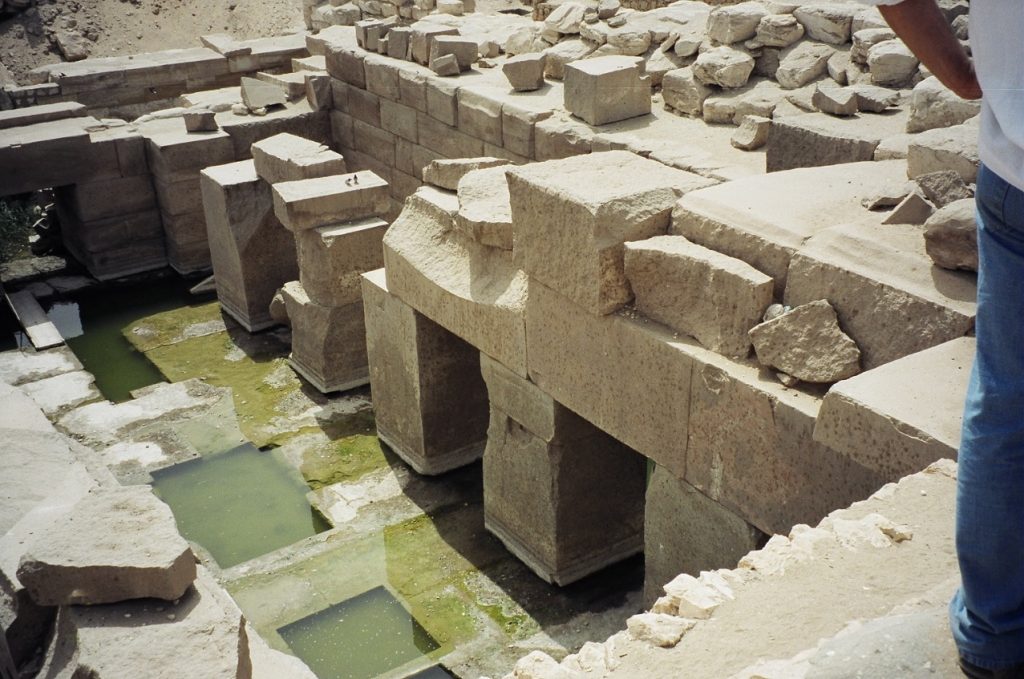
The Osireion at Abydos, [CC BY 3.0]
As ever, there are more questions than answers. Nevertheless, it is comforting, if somewhat chastening, to reflect that the Kolbrin records an astonishing gift once offered to humanity:
‘From the Children of God to the Children of Men. Behold, we found you in bondage to mortal bodies and bestowed upon you the gift of everlasting life.‘46
References
1 The Kolbrin, Manuscripts 1:8-10.
2 The Kolbrin, Sons of Fire 13:14-15.
3 The Kolbrin, Sons of Fire 13:13.
4 The Kolbrin, Manuscripts 1:23.
5 The Kolbrin, Manuscripts 33:24.
6 The Kolbrin Book of Scrolls, Chapters 9-12; Book of the Sons of Fire, Chapter 2.
7 The Kolbrin, Book of Scrolls, Sacred Registers 9:1.
8 The Kolbrin, Sons of Fire 2:1.
9 The Kolbrin, Sons of Fire 2:2.
10 Heb Sed – What Happened in the Rite? Robert Bauval, Graham Hancock Forum, November 16.
11 The Kolbrin, Manuscripts 33:25.
12 The Kolbrin, Manuscripts 33:26.
13 Shinar, an ancient name for part of Mesopotamia.
14 The Kolbrin, Manuscripts 34:21-29.
15 The Kolbrin, Manuscripts.
16 The Complete Royal Families of Ancient Egypt, Aidan Dodson & Dyan Hilton (Thames & Hudson, 2004).
17 J. Hill, Ancient Egypt Online 2016.
18 The Kolbrin, Sons of Fire 2:12-20.
19 The Kolbrin, Creation 2:11. The Kolbin says that ‘God implanted… the Seed of a Soul and the Spark of Divinity, and man the mortal became man the heir of God and the inheritor of immortality’—but that subsequent interbreeding between species shortened human beings’ lives considerably.
20 This sounds extraordinarily like the Welsh goddess Ceridwen and her Cauldron of Rebirth – could there be a cultural connection? The word ‘cauldron’ (Middle English caudroun/ kawdron) sounds remarkably similar to ‘Koriladwen’ and could well be derived from it.
21 The Kolbrin, Book of Scrolls, Sacred Registers 9:1.
22The Kolbrin, Celtic Books, The Book of the Silver Bough, Chapter 2, The Teachings of Elidor 1.
23 ‘The Famous Sadhu of Lahore’, The Spectator Archive (15th September 1928).
24 ‘The servant… began pouring warm water over the figure… The legs and arms of the body were shrivelled and stiff, the face full, the head reclining on the shoulder like that of a corpse… the medical gentleman… could discover no pulsation in the heart, the temples or the arm. There was, however, a heat about the region of the brain… The servant then recommenced bathing him with hot water… Runjeet Singh taking his right and I his left leg, to aid by friction… (during which time the servant placed a hot wheaten cake… on the top of the head…) He then pulled out of his nostrils and ears the wax and cotton with which they were stopped; and after great exertion opened his mouth by inserting the point of a knife between his teeth, and, while holding his jaws open with his left hand, drew the tongue forward with his right – in the course of which the tongue flew back several times to its curved position upwards, in which it had originally been, so as to close the gullet.’
25 My Experiences Preceding 5000 Burials, Hamid Bey (The Coptic Fellowship of America, 1938, 1951).
26 René Adolphe Schwaller de Lubicz, Henry R.H. Hall, Edgar Cayce, John Anthony West and Helena Petrovna Blavatsky.
27 The Kolbrin, Scrolls, 7:10.
28 Proof of Heaven: a Neurosurgeon’s Journey into the Afterlife, Eben Alexander (Simon & Schuster, 2012).
29 This was probably what the ancient Greeks called Kykeon. Brewed from water and barley, it was used by initiates in the Rites of Demeter at Eleusis to shed their fear of death and rebirth by experiencing their mysteries. Its psychoactive properties were probably caused by the fungus Ergot on the barley. For the history of ergot, see ‘Lysergic Acid Diethylamide – LSD’ by Paul May, School of Chemistry, University of Bristol (December 1998).
30 This might refer to El-Arish, a place on the Egyptian coast of Sinai. According to the inscription on the El-Arish Stone found in the area, Arish is known to date back to at least 1500 BC. Warak Arish Mahshi (stuffed grape vine leaves) is a popular Middle Eastern dish; the name suggests that it was named after a grape-growing area called Arish.
31 Orris is a ground-up root made from the Iris flower, once said to be used ‘for digging deep into the Moon-ruled subconscious and uprooting what is hidden. Like any Moon herb, it can also be used in divination and dreamwork’. It was ‘used in communications with the invisible realms’ (Materia Magica, Draja Mickaharic, Lulu.com, 2010). ‘The odor of this flower root or oil is said to strengthen the connection between the conscious mind and the psychic centers’ (Witch’s Travel Guide to Astral Realms, D. J. Conway, Llewellyn Publications; 2 edition 2009).
32 The black fungus was most probably a variety of psilocybin mushroom or ‘magic mushroom’, a large group of fungi which contain psychedelic compounds whose effects can be hallucinogenic. See ‘The entheomycological origin of Egyptian crowns and the esoteric underpinnings of Egyptian religion’ by Stephen R. Berlant. He writes: ‘Osiris was the God of spiritual rebirth, because he originally personified Psilocybes, the Amanita muscaria and, probably, the Amanita pantherine.’ This article theorises that ‘the plant known as the Eye of Horus, which Egyptians included in cakes and ales they concocted to spiritually rebirth the living and the dead, was intimately associated with Osiris, because this eye symbolized an entheogenic mushroom cap that was the Egyptian analogue of Soma.’
33 The Kolbrin, Scrolls, 7:2-11.
34 The Kolbrin, Scrolls 9:1-21.
35 The Kolbrin, Scrolls 33:13.
36 In his book The House of the Hidden Places and The Book of the Master, W. Marsham Adams (1837-c.1933), Fellow of New College, Oxford and a respected Egyptologist, wrote of ‘the strange collections of sacred writings, or Ritual of Ancient Egypt which modern writers have called the “Book of the Dead,” but which claims for itself the title of the Book of the Master of the Hidden Places.’ Unfortunately, Marsham Adams omitted to say where he found the phrase ‘Master of the Hidden Places’.
37 The Kolbrin, Sons of Fire, chapter 2.
38 The temple described in the Kolbrin might be Ramses III’s temple at Karnak, and the ‘caves of initiation’ might have been reused and rebuilt dynasties later by the Pharaoh Taharqa. The Edifice of Taharqa is thought to have had some ritual rebirth purpose. The excavation notes include the following observation: ‘The theological substratum is indeed very ancient… Whatever precedents it may have had, whether a building of Shabaka or of an earlier pharaoh, have yet to be found.’ The excavators also note that the so-called ‘Nilometer’ had some other, unidentified purpose, that both the west wall and the southern face of the building are heavily damaged and that every relief and inscription on the eastern half of the wall has disappeared.
39 The Edifice of Taharqa by the Sacred Lake of Karnak, Richard A. Parker, Jean Leclant, Jean-Claude Goyon, Egyptological Studies Vol. 8, Brown University, 1979. ‘Generally speaking, the work of Taharqa… is patterned on that of Shabaka, but an examination of the religious themes and texts preserved in the inner rooms of the edifice shows that the tradition incorporated there goes back to a still earlier time… it remains isolated within Egyptian tradition… ‘The theological substratum is indeed very ancient… Whatever precedents it may have had, whether a building of Shabaka or of an earlier pharaoh, have yet to be found.’
40 I suggest that ‘the Temple of the Radiant Ones, many-pillared and walled about’ is what we now call the Valley Temple.
41 Egyptian Dawn, Robert Temple, page 312,
42 Egyptian Dawn, Robert Temple, page 282.
43 The Kolbrin, Sons of Fire 2:23.
44 ‘The Ritual Path of Initiation Into the Eleusian Mysteries’, Mara Lynn Keller, Ph.D. (2009); Pindar, Fragments 102 (Oxford); see Mylonas, Eleusis, 285.
45 ‘Selim Hassan: His Writings and Excavations’, compiled by Dia’ Abou-Ghazi (Cairo, 1964).
46 The Kolbrin, Manuscripts, Chapter 33.
The author welcomes correspondence with readers via [email protected].
Kolbrin text courtesy of The Culdian Trust.







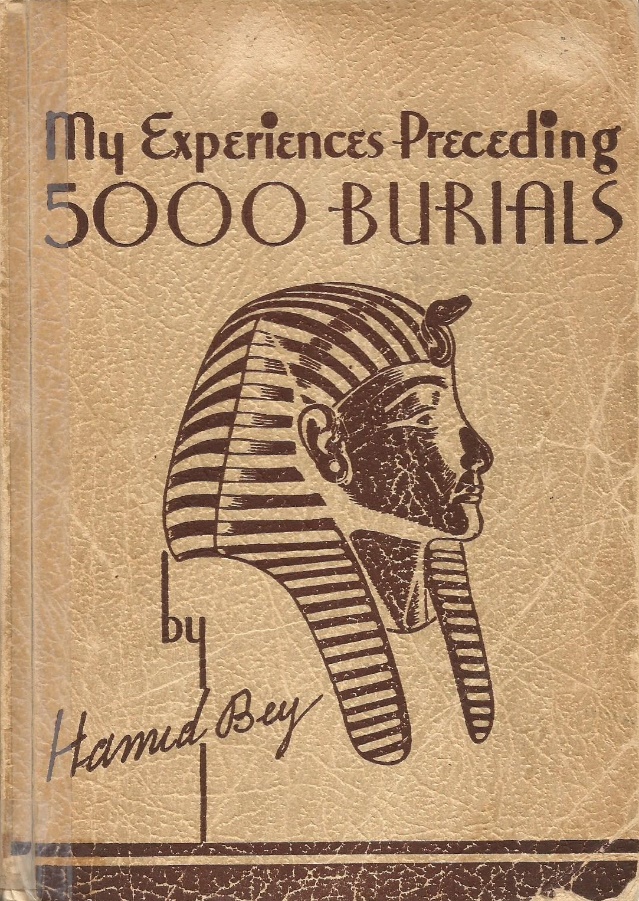
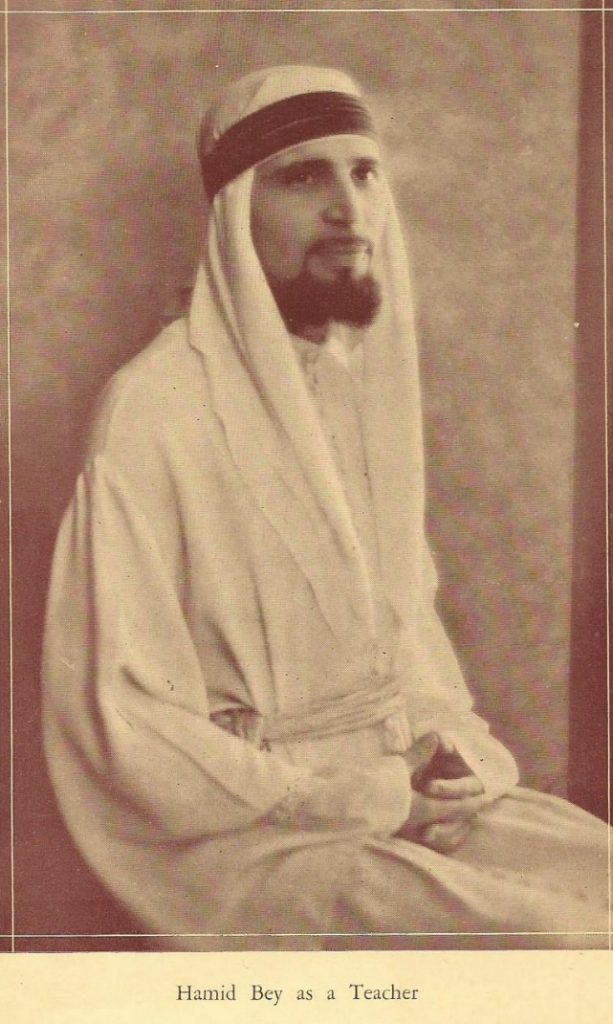
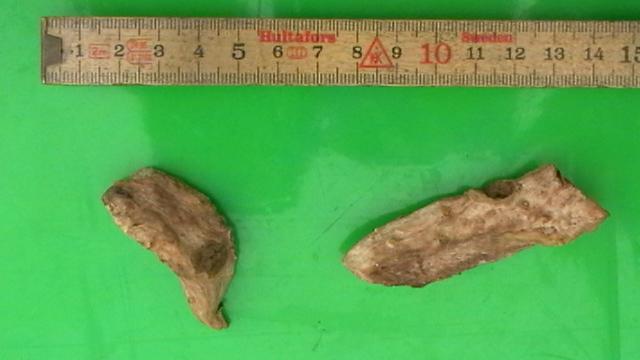
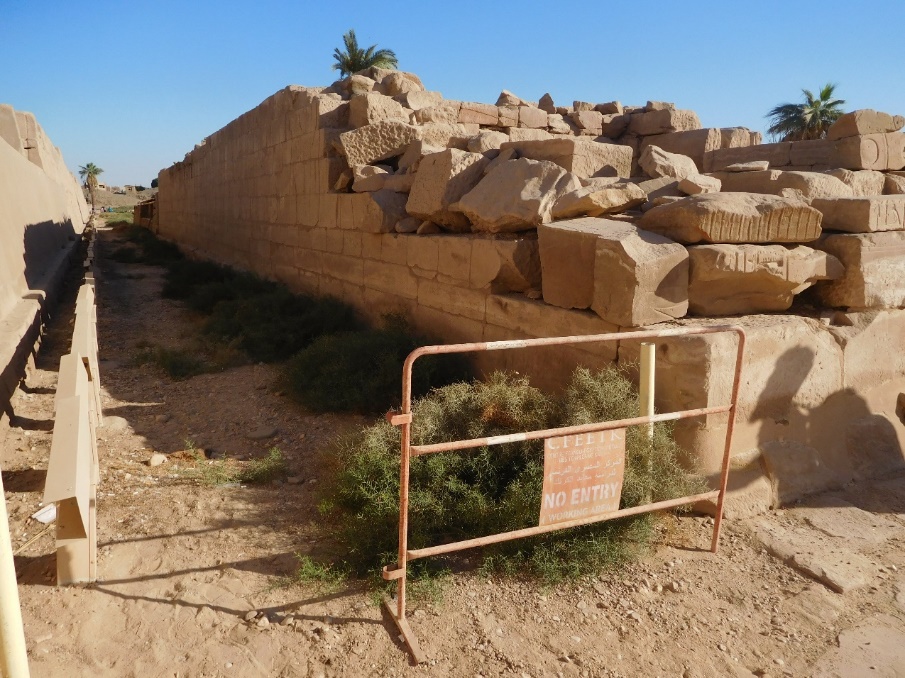
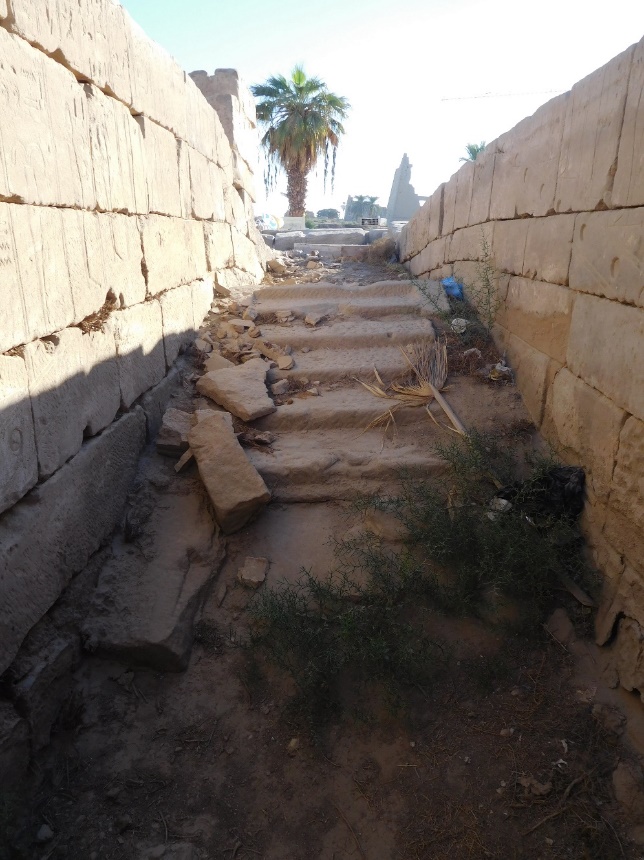
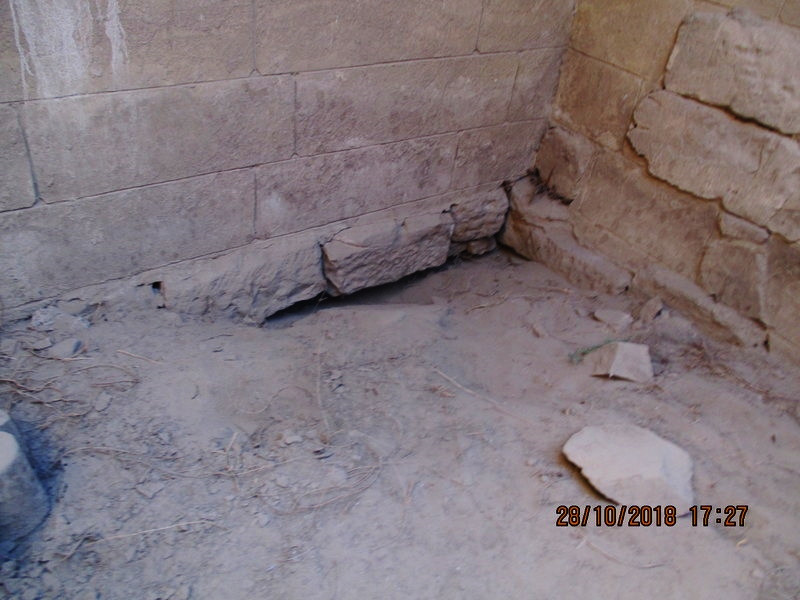
Another major contribution from Yvonne Whiteman !!! Her studies are so unique and unexpected but again showing that the Kolbrin is a compilation of books of maximum historical significance.
I love it. There is a lot to unpack here, and one thing that pops out to me is the notion to distribute the knowledge to the masses. This would probably have been unwise at the time, but done with consideration of the future, as the cycles were known, and the chance for the knowledge to survive what they knew was coming, was to mass distribute. This may have worked.
Another angle to this, is that it is not only likely that the knowledge of the 20 days, was known in Egypt and the 260 day calendar together with the 36 decans of the solar year, provide the tool to assess the longer cycles. 22 is sometimes used to indicate the result of an intention on the first day of the cycle of 20, as it usually manifests on the second day of the return. One aspect of the snake eating its tail.
Another excellent article. I have many questions pertaining to different things mentioned and now will be looking into seeking the answers. Your work, and your tenacity for seeking and spreading truth, are undaunting. I feel infinite gratitude toward you, and the handful of renegades, also spreading the truth. I trust your word, Graham Hancock.
Thank you.
Hi there,
I have read the Kolbrin twice and whenever it speaks about the twice born i keep wondering if somehow that “forgotten” or “hidden” knowledge is still available somewhere. I did a buddhist retreat last year in Kopan monastery in Kathmandu, Nepal, and they explained that inside the goompa many features could be used for every monk, but that some of them could be understood only by a few who had been taught. It is like a temple within the temple, like described somewhere in the Kolbrin also.
The other question i have about this article is that could Koriladwen be something close to ayahuasca. Because it is also written that at some point in the Kolbrin that that knowledge had been spread all over the world and that many sanctuaries had been built.
Thanks to everyone who takes time to read that comment and/or posts an answer.
I wish I’d been able to find out more about Koriladwen, which the Kolbrin describes as ‘the smooth bitter brew which releases the spirit’ and ‘the Cauldron of Rebirth and Regeneration’. The Twice Born ‘inhale the smoke from the brew of release’. Is ayahuasca inhaled as well as consumed? ‘Cauldron’ and ‘Koriladwen’ sound so similar that I wonder whether we get the word ‘cauldron’ from the Egyptian(?) name.
Well, could Koriladwen be the celtic name equivalent of the brew used in ancien egypt? Since the Kolbrin was kept in britain, maybe the name was translated.
I know from Hancock that DMT, which is the active component of ayahuasca, can be smoked as well.
I dont know if we have the word cauldron in egyptian, but i know from susan morrow in her Dawning Moon of the Mind that the words “tantra” and “mantra” come from egypt. She also states that in the pyramid texts they talk about chakras and kundalini. I wonder what would happen if a buddhist monk was to drink ayahuasca. It seems to be the requisite combination for the participants of the Hibsathy Ritual: highly advanced in meditation and spirituality + the brew.
Hi everyone,
I have read the Kolbrin twice and when it speaks about the twice born i cant help wondering if that knowledge is still available somehow.
Last year i did a buddhist retreat in Kopan monastery in Kathmandu, Nepal and they explained that there are many features in the goompa that are understandable only to the few monks that are initiated. It is mainly concerning the tantric knowledge. However it is in plain sight for everyone to see. Our teacher said it is like a temple within the temple, exactly as stated in the Kolbrin somewhere. So maybe some monks have inherited that knowledge when it was spread out of Egypt.
The other question i would like to ask in regard with this article is about the Koriladwen. To me, it sounds a bit like ayahuasca, doesnt it? I havent drunk that brew yet, but according to what i have read on that topic, it looks similar.
Thanks to Yvonne Whiteman for sharing her works with us and to anyone who woumd read and comment my post.
Hello great article, are you the next guest author
“‘The ladder leads onto a plateau, and beside you appears the… Reciter… He leads you to the place where sleeps a serpent, and… says, “Behold the serpent it sleeps at the bole of a tree from which hangs the body of man, the tree of his backbone. It is on guard, safeguarding the precious gem of spiritual powers… To rouse this serpent… causes a fire to mount into the heart, which may destroy the brain with delusions and madness. Only the Twice Born can really obtain the gem.” –> This refers to kundalini yoga as practiced by Hindus (definitely dangerous if not practiced correctly) – it is also referred to in Sufi texts and in Kaballah (Shekinah and Kopf). Wonder if there are more references to this in Kolbrin
I believe this is the only reference in the Kolbrin books to kundalini. Knowing that the kundalini concept existed in both India and Egypt raises the question of where it originated. The Kolbrin contains another note on the Hibsathy. Describing the lost land from which the advanced peoples came to Egypt, the Book of Scrolls says, ‘Seven years men being chosen waited and were called. Seven years they served and seven years they ministered at the feet of their Masters of Instruction. They were passed into bleak caverns to die and know God, and called forth with the sure knowledge of Truth.’ The Book of Manuscripts says, ‘Now the Great House of the Hidden Places stands in Kahemu [Egypt].’ This implies that in an earlier time it stood outside Egypt. All this tells us that the refugees who came to Egypt carried the Hibsathy ritual with them from their lost land.
HIBSATHY. The word Hibsathy should be read as an Egyptian of the time would have made it: HIB SA THY, in practice three letters HIB (Ibis, Toth) – biletters (SA, Son) – three letters THY (Lord, god). Translated the word has this meaning: “Son of the God Ibis (Thot)”. So the initiates who passed the tests and became “twice born” were evidently called “Sons of the Ibis” then “Sons of Toth”. The god Toth was a lunar deity whose function was to “measure time”, so that the initiates became able to “measure time”, to live for seven days “estranging” from time, they acquired the ability to dominate, inside of oneself, the psychic-spiritual place par excellence: the Mind! For the principles codified in the “Emerald Tablet”, attributed to Toth-Hermes, in effect, Mind is the centre that unifies us to the Universe from the spiritual point of view. If you look closely at the sculpture of King Djoser that you have published, you will notice that the pharaoh must cross a door guarded at the bottom by a banded baboon (Enwrapped One) and above by a bird that can only be an ibis, the sacred animals of Toth. I agree with you on the extraordinary resemblance of this rite with that practised in Eleusis. Much, if not all, of Egyptian culture, was incorporated into Greek rituality and in particular this was translated into the Eleusinian Mysteries: Small Mysteries and Great Mysteries. Even in these Eleusinian Mysteries a drug was used to alter the psychic state of the new initiate: it was called “ciceone”, extracted from fermentation of rye infested with a parasitic fungus.
HEB SED. This was a party/ceremony dedicated to the god Sethi, also called Set or Sed. It was already celebrated before 3500 A.C. It is a development/adaptation of a very bloody ceremony. The Pharaoh who was no longer able to bear the burdens of the kingdom was ritually killed, probably even before the invasion of the Hyksos. Then it was transformed into a ritual race, three turns around the temple, which served to verify the vigour of the Pharaoh. It was celebrated at the end of the thirtieth year of reign (corresponding to the time of a generation) and then every three years. Why Sethi? Because this god accompanied the spoils of the Pharaoh on the boat to Ra on his last journey to Ra: it was the direct witness that the Pharaoh could still reign.
I have queried Claudio Martano’s statement that the Heb Sed was ‘a development/adaptation of a very bloody ceremony’ in which a Pharaoh who was past his useful life was put to death. Martano tells me this is a hypothesis put forward by the Egyptologist Flinders Petrie, perhaps influenced by the chapter ‘King of the Wood’ in George Frazier’s book The Golden Bough. This much-discussed hypothesis does not seem to be backed up by any ancient written record or inscription.
I query Claudio Martano’s statement that the Heb Sed was ‘a development / adaptation of a very bloody ceremony’ in which a Pharaoh past his useful life was put to death. Martano tells me this is a hypothesis put forward by the Egyptologist Flinders Petrie, perhaps influenced by George Frazer’s book ‘King of the Wood’ in The Golden Bough. The hypothesis is much discussed, but is not backed up by any ancient written record or inscription.
Thank you so much for your research during all the years!!!
I’ll hope someday you going to publish your insightful insights! Can’t wait to have a book with all this information to my hand!
One question: could you Recommend a printed version of the Kolbrin?
Best wishes!
A.
Very informative. Thank you.